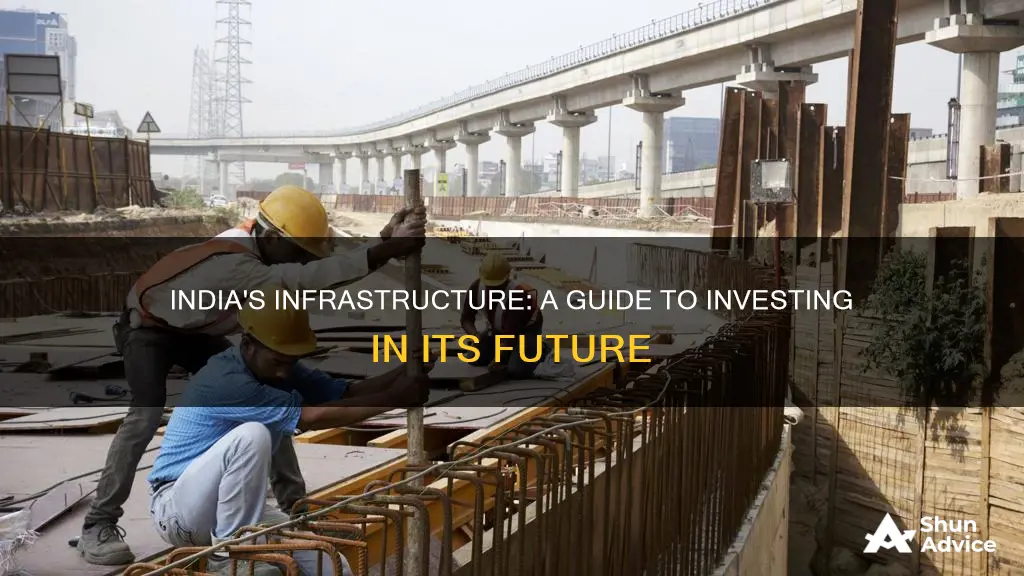
India's journey towards becoming a developed nation by 2047 is heavily reliant on improving its infrastructure. The government has demonstrated its commitment to this goal by allocating 3.3% of its GDP to the infrastructure sector in the 2024 fiscal year, with a particular focus on transport and logistics. This article will explore the various investment opportunities in India's infrastructure sector, including public-private partnerships, mutual funds, and infrastructure stocks. We will also discuss the types of infrastructure systems and the key considerations for investors looking to enter this market.
| Characteristics | Values |
|---|---|
| Infrastructure sectors | Transportation, utilities, communication, energy |
| Infrastructure systems | Soft, hard, critical |
| Soft infrastructure examples | Financial institutions, law enforcement, education systems |
| Hard infrastructure examples | Highways, roadways |
| Critical infrastructure examples | Energy, telecommunication, electricity, agriculture, public health |
| Infrastructure stocks | Bharti Airtel, Ashok Leyland, GMR Airports Infrastructure Ltd, IRB Infrastructure Developers Ltd, Ircon International Ltd, G R Infraprojects Ltd, Reliance Industries Ltd, Techno Electric & Engineering Company Ltd |
| Mutual funds | Canara Robeco Infrastructure Fund, Bandhan Infrastructure Fund, Quant Infrastructure Fund, UTI Infrastructure Fund, ICICI Prudential Infrastructure Fund, SBI Infrastructure Fund |
| Infrastructure projects | Bharatmala Pariyojana, PM Gatishakti National Master Plan, National Logistics Policy, National Infrastructure Pipeline, Sagarmala |
| Infrastructure companies | Larsen & Toubro Ltd, GMR Airports Inf Stocks, IRB Infra. Devl. Shares, Ircon International Limited, RITES Limited, G R Infraproject Stocks, HFCL Ltd, Engineers India Stocks, Reliance Infra. Shares, Techno Elec.Engg Stocks |
What You'll Learn

Investing in India's transport infrastructure
India's transport infrastructure is a key driver of the country's economic growth and overall development. The Indian government has recognised the need to improve its transport network to support its goal of becoming a developed nation by 2047. This includes enhancing road, rail, aviation, and shipping infrastructure to cater to the needs of its growing population and economy. As such, there are numerous investment opportunities in this sector, which is expected to attract the majority of infrastructure investments in India until 2035.
Roads
Roads are the dominant mode of transportation in India, carrying almost 85% of the country's passenger traffic and over 60% of its freight. However, most roads in India are narrow, congested, and poorly surfaced. The Indian government has set ambitious targets for road development, including constructing 2 lakh km of national highways by 2025. This presents opportunities for investors to partner with the government in building and improving road infrastructure.
Railways
Indian Railways is one of the largest railway networks under single management, carrying millions of passengers and freight daily. However, it faces severe capacity constraints, particularly on major corridors. The government has allocated significant funds for the development and maintenance of railways, including the creation of dedicated freight corridors to free up passenger train networks. There is also a focus on semi high-speed Vande Bharat trains, with an allocation of INR 2.4 lakh crores for their development and maintenance.
Aviation
India's aviation industry is expected to experience double-digit growth, with passenger traffic projected to quadruple and cargo traffic to increase sixfold in the next two decades. To keep up with the growing demand, the aviation industry will require investments of USD 30 billion over the next 15 years. This includes expanding and improving airport infrastructure, as well as enhancing ground handling, night landing systems, and cargo handling capabilities.
Shipping and Inland Waterways
With a vast coastline of 7,500 km and 14,500 km of navigable waterways, India has untapped potential in shipping and inland waterways. The government's Sagarmala project aims to improve port infrastructure and connectivity, with investments of over USD 80 billion expected by 2025. This presents opportunities for investors in port development, port connectivity, and inland waterway projects.
Urban Transport
India is experiencing rapid urbanisation, with a growing need for efficient and sustainable urban transport systems. However, only a handful of cities have organised transport systems, and the share of public transport has declined in recent years. There are opportunities for investors to partner with the government in developing mass rapid transit systems, improving road safety, and introducing innovative solutions such as shared mobility and electric vehicles.
Investment Opportunities and Partnerships
The Indian government actively seeks foreign investment to finance its large-scale transport infrastructure projects and has introduced regulatory reforms to attract more investment. Public-Private Partnerships (PPPs) are a crucial mechanism for private sector engagement, particularly in the construction of airports, ports, highways, and logistics parks. Additionally, the National Infrastructure Pipeline (NIP) and the PM GatiShakti National Master Plan offer a range of investment opportunities across various transport sub-segments.
Retirement Planning: Understanding 401(k) Investment and Savings Plans
You may want to see also

India's growing digital infrastructure
India's growing digital public infrastructure is integral to its commitment to inclusive growth and is a cornerstone for fostering liveable, climate-resilient, and inclusive cities that drive economic growth. The country has made significant strides in this area, with the government positioning digital public infrastructure as a key pillar of its G20 presidency.
One of the most notable achievements is the Unified Payments Interface (UPI), which has revolutionized digital payments in India. UPI transactions have seen exponential growth, increasing from 92 crore in FY 2017-18 to 8,375 crore in FY 2022-23. The system has expanded internationally, with countries like the UAE, Singapore, and France adopting or considering UPI. Recent developments include the integration of UPI with credit cards and the launch of UPI Lite for offline transactions, enhancing financial inclusion and positioning India as a global leader in digital payments.
Another key component of India's digital infrastructure is the Aadhaar system, a biometric identification platform that provides a unique digital identity to over 1.4 billion citizens. The JAM Trinity (Jan Dhan-Aadhaar-Mobile) strategy has accelerated financial inclusion, enabling large volumes of digital payments and improved financial access through micro-lending and pensions. This strategy has also helped reduce leakages in government transfers, resulting in substantial savings and an increase in the Tax Revenue to GDP ratio from 8.2% to 17.1%.
The Open Network for Digital Commerce (ONDC) is another ambitious initiative. By creating an open network, ONDC challenges existing e-commerce monopolies and provides a level playing field for small and medium enterprises. This initiative is expected to bring 30 million sellers and 10 million merchants online, promoting inclusive growth and a more equitable digital economy.
The Ayushman Bharat Digital Mission, which includes the CoWIN platform, has played a crucial role in facilitating rapid vaccination during the Covid-19 pandemic, streamlining processes from scheduling to certificate issuance. As of December 2023, 50 crore individuals have adopted the Ayushman Bharat Health Account (ABHA) as their unique health ID. Additionally, telemedicine consultations have surged, with platforms like eSanjeevani conducting over 100 million consultations, improving healthcare access and efficiency across India.
India has also made strides in digital identity systems, data infrastructure, cybersecurity frameworks, and broadband connectivity. The country aims to continue leveraging its digital public infrastructure to drive innovation in areas like artificial intelligence, data protection, and decentralised infrastructures.
To further enhance its digital infrastructure, India should focus on several key strategies. These include increasing investment in cybersecurity, implementing interoperability standards, developing inclusive digital literacy programs, establishing a Cyber Security Board, and adopting agile regulatory frameworks. Additionally, expanding broadband connectivity, promoting vernacular digital content, and embracing green digital infrastructure are also crucial steps to ensure sustainable and inclusive growth in the digital domain.
Robinhood Investing and Portfolio Management: A Beginner's Guide
You may want to see also

India's energy and utilities infrastructure
Energy Consumption and Production:
- India is the third-largest producer and consumer of electricity in the world, with a total electricity generation of 1,949 TWh during the 2023-24 fiscal year.
- The country has a diverse energy mix, with coal, oil, natural gas, and renewable sources contributing to its energy production.
- India is the second-largest consumer of coal and the third-largest consumer of oil globally.
- The country is a net energy importer, meeting nearly 47% of its total primary energy needs through imports.
Renewable Energy:
- India has made significant strides in renewable energy investments and installations and is one of the world leaders in this sector.
- As of March 2024, India had an installed capacity of 190.573 GW of renewable energy, accounting for 43% of its total installed capacity.
- The government has set ambitious targets for renewable energy, including 175 GW by 2022 and 450 GW by 2030.
- Solar, wind, hydropower, and biomass are key focus areas for renewable energy development.
Energy Infrastructure:
- India's energy infrastructure includes a vast network of power plants, transmission lines, and distribution systems.
- The Indian national electric grid has an installed capacity of 442.0 GW as of March 2024 and covers almost the entire country.
- The government has been working towards strengthening the energy infrastructure by integrating various regional grids into a National Grid.
- There is a growing focus on renewable energy infrastructure, with the government declaring its commitment to increasing investments in this sector.
Utilities Infrastructure:
- India's utilities infrastructure includes electricity, water, and gas supply systems.
- The electricity supply infrastructure has achieved significant coverage, with 99.99% of the population having access to power.
- The government has initiatives such as the "Power for All" program, which aims to ensure uninterrupted electricity supply to all households, industries, and commercial establishments.
- Water and gas supply infrastructure is also undergoing development, with projects like the National Hydroelectric Power Corporation and the National Gas Grid aiming to improve access and supply.
Investment Opportunities:
- The energy and utilities sector in India offers a range of investment opportunities for both domestic and foreign investors.
- Public-Private Partnerships (PPPs) have been identified as a key mechanism to accelerate infrastructure development and attract investments.
- The National Infrastructure Pipeline (NIP) envisages an investment of INR 111 Lakh Cr over five years, offering various projects for private sector participation.
- The India Investment Grid (IIG) is a government initiative that showcases investment opportunities across different sectors, including energy and utilities.
- Renewable energy projects, stressed asset turnaround, and Corporate Social Responsibility (CSR) initiatives are some of the specific areas where investors can explore opportunities.
In conclusion, India's energy and utilities infrastructure is undergoing significant development and offers a range of investment prospects. The country's focus on renewable energy, strengthening its grid, and improving access to electricity and utilities makes it an attractive destination for investors looking to contribute to and benefit from this dynamic sector.
Fees in Investment Portfolios: What's the Ideal Percentage?
You may want to see also

India's physical infrastructure
To meet India's aim of reaching a US$5 trillion economy by 2025, infrastructure development is crucial. The government has launched the National Infrastructure Pipeline (NIP) to augment the growth of the infrastructure sector. Under the NIP, projects worth Rs. 108 trillion (US$1.3 trillion) are currently at different stages of implementation. The NIP project count now stands at 9,142 projects covering 34 sub-sectors. Nearly half of the under-development projects are in the transportation sector, and 3,906 are in the roads and bridges sub-sector.
The government has set ambitious targets for the transport sector, including developing a 200,000-km national highway network by 2025 and expanding airports to 220. Additionally, plans include operationalizing 23 waterways by 2030 and developing 35 Multi-Modal Logistics Parks (MMLPs). Roads and Highways account for the highest share of the budgetary outlay for infrastructure-related ministries, followed by Railways and Urban Public Transport.
The Bharatmala Pariyojana, under the NIP, is progressing with Phase I focusing on developing 34,800 km of National Highways. It emphasizes corridor-based development and is set to conclude by 2027-2028, covering 31 States/UTs and over 550 districts. The government also targets building 22 new greenfield expressways, signalling significant advancements in India's transportation infrastructure.
The railway sector in India is also undergoing ambitious projects. The Mumbai-Ahmedabad Speed Rail Corridor, for example, will be the world's highest pier bridge once completed. Additionally, the Chenab bridge in Jammu & Kashmir will be the world's highest railway bridge. With a total Broad Gauge network of 61,508 km electrified as of December 2023, the sector has also introduced 35 indigenously designed Vande Bharat Express trains, with six more set to launch soon. These trains serve up to 247 districts across the country.
The port sector in India has also seen significant improvements. The "Sagarmala" scheme, under the Ministry of Ports, Shipping and Waterways, promotes port-led development by harnessing India's 7,500 km long coastline and 14,500 km of potentially navigable waterways. The country's total port capacity is expected to increase from the existing 2,600 MTPA (Million Tonnes per annum) to more than 10,000 MTPA by 2047.
To achieve its infrastructure goals, India requires significant investment from the private sector. Public-Private Partnerships (PPPs) have served as a vital mechanism for private sector engagement across various infrastructure domains, including the construction of airports, ports, highways, and logistics parks. Private sector partnerships have emerged as crucial enablers, bringing in much-needed investment, innovation, and efficiency.
Transferring Funds: Ally Invest to Ally Savings
You may want to see also

India's critical infrastructure
The transport sector is witnessing significant enhancements, with ambitious targets set by the government. These include the development of a 200,000-km national highway network by 2025, expanding the number of airports to 220, operationalizing 23 waterways by 2030, and constructing 35 Multi-Modal Logistics Parks (MMLPs). To achieve these goals, India has launched the PM Gatishakti National Master Plan (NMP), integrating various infrastructure schemes under a digital platform to streamline planning, design, and monitoring of next-generation infrastructure projects.
The country's infrastructure development also focuses on roads, railways, and ports. The Bharatmala Pariyojana project aims to develop 34,800 km of National Highways by 2027-2028, covering 31 states and union territories. The railway sector is undertaking significant projects, including the Mumbai-Ahmedabad Speed Rail Corridor and the Chenab bridge in Jammu & Kashmir, the world's highest railway bridge. Additionally, Indian Railways aims to become a net-zero carbon emitter by 2030, with substantial investments in renewable energy sources.
The development of ports is also a critical component of India's infrastructure plans. The Sagarmala programme, the flagship scheme of the Ministry of Ports, Shipping and Waterways, aims to harness India's 7,500 km coastline and navigable waterways for port-led development. The government targets an increase in total port capacity from 2,600 MTPA to over 10,000 MTPA by 2047.
To facilitate these infrastructure developments, India launched the National Infrastructure Pipeline (NIP) in 2020, envisioning an investment of INR 111 Lakh Crore over five years. Public-Private Partnerships (PPPs) have been crucial in accelerating infrastructure investments, with the private sector bringing in much-needed investment, innovation, and efficiency.
In conclusion, India's critical infrastructure development is well underway, with significant investments and initiatives across various sectors. The country's goal of becoming a global economic powerhouse is heavily reliant on the successful execution of these infrastructure projects, which will ultimately pave the way for a prosperous and sustainable future for its citizens.
India's Graphene Investment: Strategies for Success
You may want to see also
Frequently asked questions
India's infrastructure development plans include the PM Gatishakti National Master Plan (NMP), which focuses on enhancing multimodal connectivity infrastructure in various economic zones, and the National Logistics Policy, which aims to develop integrated infrastructure and improve efficiency in services. The country also launched the National Infrastructure Pipeline (NIP) in 2020, envisioning an investment of INR 111 Lakh Cr over 5 years.
India offers a range of infrastructure investment opportunities, including the Integrated Multi-Modal Logistics Hub at Nangal Chaudhary in Haryana, the Baithkol Modern Deep Sea Port Project in Karnataka, and the India International Convention and Expo Centre.
Some of the top infrastructure stocks in India include GMR Airports Infrastructure Ltd, IRB Infrastructure Developers Ltd, Ircon International Ltd, G R Infraprojects Ltd, and Reliance Industries Ltd.
India's infrastructure systems can be categorized into three types: soft infrastructure, hard infrastructure, and critical infrastructure. Soft infrastructure includes financial institutions, law enforcement, and education systems. Hard infrastructure refers to physical systems such as highways and roadways. Critical infrastructure includes energy, telecommunication, electricity, and agriculture.
Investing in mutual funds focused on India's infrastructure sector offers diversification and potential growth opportunities. These funds invest in communication networks, transportation systems, and utilities, providing exposure to various industries. Examples of such mutual funds include the Canara Robeco Infrastructure Fund, Bandhan Infrastructure Fund, and Quant Infrastructure Fund.







